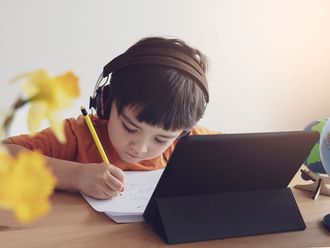
Abu Dhabi: Technology has been available for a while now, but the sudden switch to distance learning during the COVID-19 pandemic has really pushed teachers to embrace it, a principal at an Al Ain-based school said.
“Even after this outbreak, online assets will continue to tighten teaching and learning, include live teaching and live broadcasts. We also found that some children did better through distance learning, and that it was easier to confer with parents, who could spare 15-20 minutes from their workday rather than coming down to the school physically,” Chris Nourse, who heads the Al Ain Academy, told Gulf News.
With that being the case, Nourse does not believe that distance learning — even with all the flexibility it offers — can fully replace pupil-teacher relationships forged in a classroom.
Brick-and-mortar schools
“When I look back at my own time in school, it were my teachers who spurred me on, saw something in me. I don’t think anything can take away the wonders of student-teacher relationships,” Nourse said, implying that these strong bonds are forged in brick-and-mortar schools. In fact, a major downside of distance learning is the sense of isolation it brings about.
For a student’s wellbeing, the school therefore organised sessions to allow children to chat with one another, while PE teachers carried out extra-curricular activities and challenges using online resources.
‘Beta-tested distance learning’
The shift to distance learning, nevertheless, did help teachers develop new skills. “We had beta-tested distance learning, but we trained staff for two weeks before the actual roll-out. Many teachers also learned to become TV presenters overnight, and to develop online content,” Nourse added.
There were other challenges as well. Many teachers had to record content in the evening after their own household chores were out of the way. Several others had to manage young children with clever scheduling. The school head himself had three children attending distance learning classes in Grades 8 and 11 at the same time as he was working.
‘Learning a new way to work’
“My children were old enough to adapt to the new normal and I would alert them when I had a meeting so that I would not be disturbed,” Nourse said.
“Of course, there was a lot of slippage between working hours and after-work hours, and the delineation [of space and time] between work and home did get blurred. But I believe this may have happened because we were all learning a new way to work. For instance, I wanted to be available, to look after teachers’ wellbeing, so I would often get calls late into the evening,” he added.









